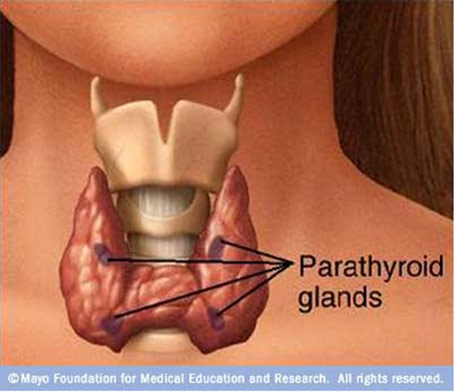Parathyroid surgery procedures
The parathyroid glands are four pea-sized glands located in the neck near the thyroid gland
- Occasionally one or more of the parathyroid glands may be embedded elsewhere in the neck, such as in the thyroid, in the thymus, or located in the chest – in most of these situations, the glands function normally
- The parathyroids and thyroid are part of the endocrine system which control body functions by the production of hormones – though their names are similar, the thyroid and parathyroid glands are entirely different glands, each producing distinct hormones with specific functions
- The parathyroid glands purpose is to secrete parathyroid hormone (PTH), a hormone that helps maintain the correct balance of calcium and phosphorus in the body
- PTH regulates the level of calcium in the blood, release of calcium from bone, absorption of calcium in the intestine, and excretion of calcium in the urine – when the level of calcium in the blood falls too low, the parathyroid glands secrete just enough PTH to restore the blood calcium level

Why are calcium and phosphorus so important?
- Calcium is essential for good health – it plays an important role in bone and tooth development and in maintaining bone strength
- Calcium is also important in nerve conduction and muscle function and strength
- Phosphorus is found in all bodily tissue – it is a main part of every cell with many roles and combined with calcium, phosphorus gives strength to the bones and teeth
Parathyroid disease
What is hyperparathyroidism?
- Hyperparathyroidism is a condition in which the parathyroid gland makes more of the PTH than it needs, causing an imbalance in the amount of calcium in the body
- This can lead to problems with the bones, muscles, nervous system, and kidneys
- Hyperparathyroidism is caused by inappropriately increased secretion of parathyroid hormone (PTH)
- If the parathyroid glands secrete too much hormone (PTH), the balance is disrupted and the blood calcium level rises
- This condition of excessive calcium in the blood, called hypercalcaemia, is the first sign that something may be wrong with the parathyroid glands
- “Primary” means this disorder originates in the parathyroids: One or more enlarged, overactive parathyroid glands secretes too much parathyroid hormone (PTH), inappropriate to the serum calcium level
- In 85 % of people with primary hyperparathyroidism, a benign tumour called an adenoma has formed on one of the parathyroid glands, causing it to become overactive
- In most other cases, the excess hormone comes from two or more enlarged parathyroid glands, a condition called hyperplasia – very rarely, hyperparathyroidism is caused by cancer of a parathyroid gland.
- Excess PTH triggers:
- The release of too much calcium into the bloodstream
- The bones may lose calcium
- Too much calcium may be absorbed from food
- The levels of calcium may increase in the urine, causing kidney stones
- PTH also lowers blood phosphorus levels by increasing excretion of phosphorus in the urine
When is parathyroid surgery needed
- Parathyroid gland surgery is needed where there is:
- Overactivity of one or more gland
- Parathyroid cancer (a very rare condition)
- Surgery to remove a parathyroid gland is called a parathyroidectomy
Parathyroid surgery treatment
- Surgery to remove the enlarged parathyroid gland (or glands) is the main treatment for primary hyperparathyroidism and cures it in 95 percent of patients
- Surgery may be a minimally invasive parathyroidectomy procedure or an open parathyroidectomy




